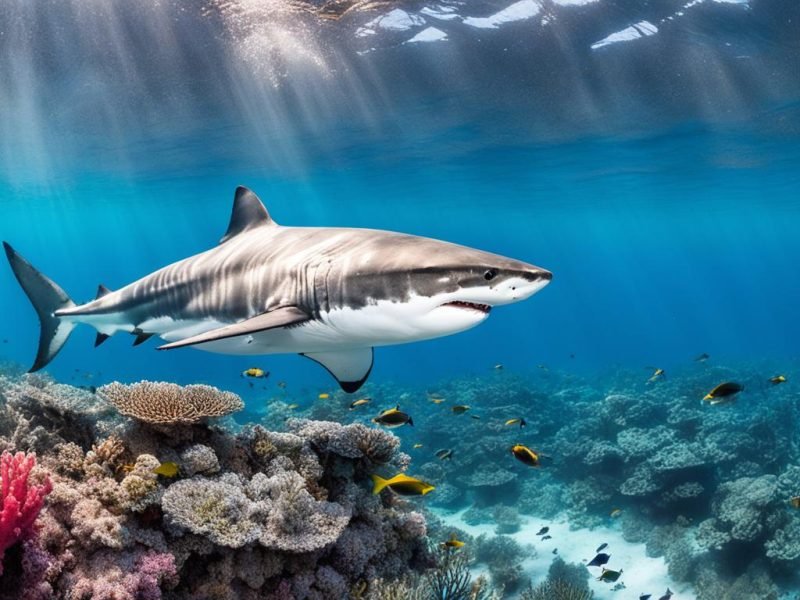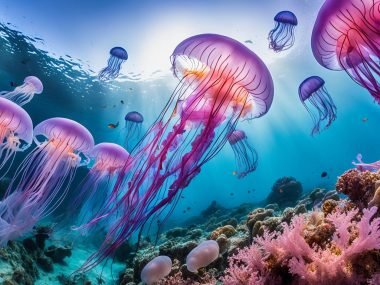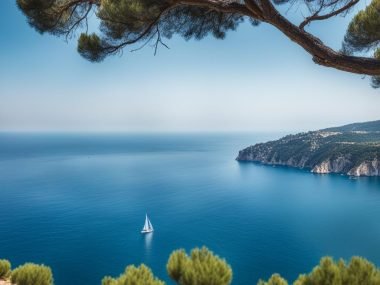Contrary to the serene coastal views that Tunisia presents, the depths of its waters tell a less tranquil story. Tunisia, a country famed for its rich history and vibrant culture, remains a subject of intrigue for the marine enthusiasts and travelers alike, raising the question: Are Sharks In Tunisia? Indeed, the answer swims in the affirmative. The Tunisian segment of the Mediterranean Sea is not only picturesque but is also quietly abode to an array of shark species. Though Shark Sightings Tunisia are not often headlined, the waters of Tunisia host an underwater ballet of these enigmatic creatures, enriching the marine tapestry of the region.
Sharks, the apex predators of the oceans, have carved a niche for themselves in the ecological hierarchy of Tunisia’s waters, but their presence is as elusive as it is fascinating. As the sun flirts with the Mediterranean horizon, beneath the waves, the sharks continue to play their integral role in maintaining the health of marine ecosystems. Yet, this aspect of Tunisian maritime life escapes the limelight, with most visitors unaware of the mysterious residents patrolling the depths of the Sharks Tunisia coastlines.
Key Takeaways
- Tunisia is home to diverse shark populations, including sizable predators.
- Shark sightings are rare but substantiate the presence of sharks in Tunisian seas.
- Protection of Tunisia’s marine biodiversity is pivotal for the survival of these species.
- Understanding the significance of Tunisian waters for sharks is essential for their conservation.
- Increased awareness of the marine life in Tunisia, including sharks, can enhance ecological tourism and interest.
Overview of Tunisia’s Marine Ecosystem and Shark Population
The splendor of the Mediterranean Sea is vividly encapsulated in the rich marine biodiversity found within Tunisian waters. Home to a wealth of marine species, Tunisia serves as an aquatic sanctuary for a multitude of marine life, including a notable array of shark and ray populations. Striking a delicate balance in their marine environment, these species are pivotal to the health of the underwater ecosystem. Yet, the serene existence of these creatures is under continuous threat from human activities – especially from local fisheries – that impact their numbers and disrupt their natural habitats.
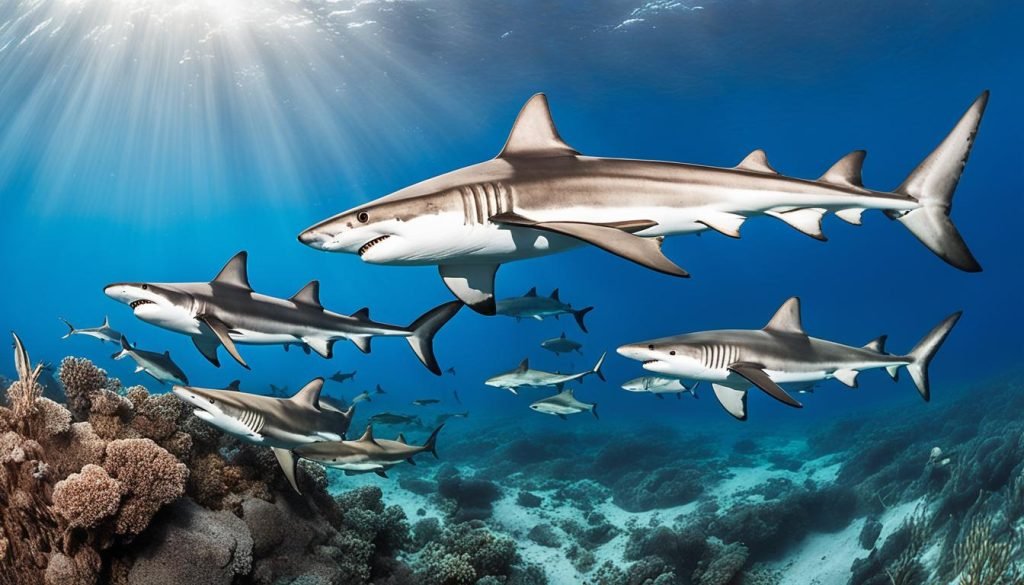
Significance of the Gulf of Gabès for Shark Species
Recognized as a critical habitat for a variety of shark species, the Gulf of Gabès is geographically distinguished by its shallow waters and an extensive continental shelf. This region represents one of the Western Mediterranean Sea’s most productive marine areas, with vast meadows of Neptune Grass serving as both a crucial ecological component and a vibrant, life-giving force to countless marine organisms. For sharks, the Gulf’s ecological bounty signifies more than just habitation; it’s a cradle for their offspring, cementing its role as a valuable ecosystem for marine conservation efforts.
Diversity of Shark and Ray Populations in Tunisian Waters
Within the realm of Tunisia’s marine ecosystem, Tunisian waters boast a rich diversity of marine life, with records showing that there are 29 shark and 21 batoid species to date. This impressive diversity signals not only the existence of a healthy and robust marine ecosystem but also showcases an environment rich with the necessary ingredients required for the growth and reproduction of these elasmobranchs. The favorable conditions of Tunisian waters serve as an incubator for the varying life cycles of shark and ray species, sustaining the biodiversity essential to ecological stability.
Impact of Local Fisheries on Shark Numbers
Local fisheries have a direct impact on the shark populations in Tunisia, predominantly through the unintentional catch associated with various fishing gears. Numerous fishing vessels, which range from modest small-scale boats to larger trawlers, traverse waters that are shared with shark habitats. This overlap frequently leads to the incidental capture alongside targeted capture by specific gillnets, particularly in the summer, threatening the delicate balance of the marine ecosystem. Such fishing practices contribute to a worrying decline in shark numbers and pose a significant conservation concern, emphasizing the need for sustainable fishing methods and protective measures for these vulnerable marine residents.
Common Shark Species Inhabiting Tunisian Seas
The vast and variegated marine landscape of Tunisia serves as an ecosystem for an array of shark species. Notable among these are the Angel Shark Tunisia and Sand Tiger Shark Tunisia, two distinct species that contribute to the region’s biodiversity. Alongside these, the waters of Tunisia also host larger and more known shark species like basking sharks and great white sharks. Detailed knowledge of these species is not just of academic interest but also fosters better understanding and conservation efforts.
Spotlight on the Angel Shark and Sand Tiger Shark
The Angel Shark, adopting a perfectly camouflaged flat-body, lies in wait for prey on the sandy seafloor of Tunisia’s coastal environments. Its counterpart, the Sand Tiger Shark, known for its fierce appearance, with protruding spike-like teeth, is a formidable yet sluggish predator, often found lurking in the waters off the Tunisian coast. Both species signify the adaptability and variety of sharks in Tunisia, each playing a critical role in the marine food web.
Mediterranean Giants: Basking and Great White Sharks
In the ranks of larger predators, the gentle giant of the sea, the basking shark, looms with its colossal mouth open, filtering plankton for sustenance. In stark contrast, the great white shark is known for its sheer size and predatory efficiency – a creature often associated with the term “apex predator.” It’s pivotal to note that the great white shark is considered highly aggressive and is one of the largest predatory fish known, while the basking shark, despite its massive size, is known for its non-aggressive nature.
Adaptations of Sharks to the Tunisian Marine Environment
Sharks in Tunisia have developed various adaptations to thrive in the Mediterranean environment. These adaptations have allowed shark species to colonize a range of ecological niches – from the warm, shallow bays perfect for the Angel and Sand Tiger sharks to the expanses of open water favored by basking and great white sharks. Developed over millennia, these biological adaptations include advanced thermoregulation, buoyancy control, and refined sensory systems, ensuring their survival in diverse conditions.
As the proverbial stewards of the sea, understanding these shark species is essential in ensuring they continue to enrich the Mediterranean’s marine tapestry. Below is a comparative overview capturing key attributes of the shark species discussed:
| Species | Diet | Typical Habitat | Nature | Conservation Status |
|---|---|---|---|---|
| Angel Shark | Fish, crustaceans, mollusks | Coastal benthic environments | Sedentary ambush predator | Critically Endangered |
| Sand Tiger Shark | Small fish, squid, crustaceans | Shallow bays, reef edges | Slow-moving, docile | Vulnerable |
| Basking Shark | Plankton | Temperate oceanic waters | Non-aggressive filter feeder | Endangered |
| Great White Shark | Marine mammals, fish | Coastal to off-shore waters | Highly aggressive predator | Vulnerable |
Shark Sightings Tunisia: Understanding Infrequent Encounters
Despite the Tunisian Shark Population inhabiting the Mediterranean’s Tunisia coasts, Shark Sightings Tunisia are notably uncommon, with very few recorded events startling the local community or visitors. This rarity can be observed as a testament to the harmonious coexistence between humans and these magnificent marine species within their shared environment, preserving the delicate balance of the Tunisia’s diverse marine ecosystem.
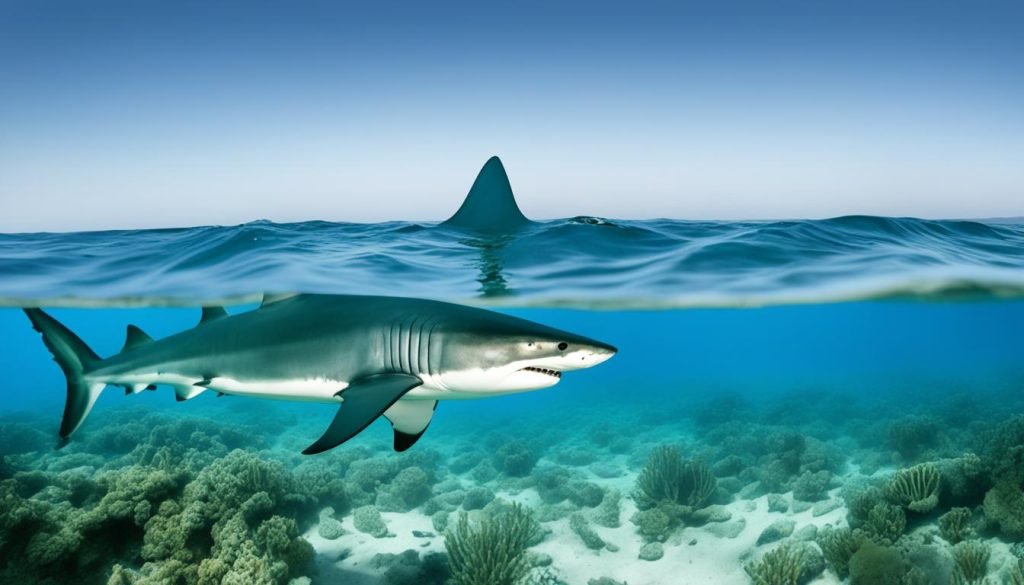
Shark sightings within Tunisian waters may spark a mixed sense of curiosity and concern; however, the interaction between these apex predators and humans remains extraordinarily limited. One of the last reported incidents, a non-fatal spearfishing mishap back in 1982, underscores the infrequency of such encounters.
While the threat to human safety from sharks is minimal, the presence of sharks nonetheless casts an important light on the health and vitality of the marine ecosystems around Tunisia. The low number of sightings does not necessarily reflect the state of the Tunisian Shark Population, but rather highlights the importance of ongoing research and monitoring activities to understand the movements and behaviors of these elusive creatures.
Through responsible and sustainable tourist and local interactions with the marine life around Tunisia, including adherence to safe practices when in the water, Tunisians and visitors alike can ensure these sporadic Shark Sightings Tunisia remain a source of enchantment rather than conflict.
Tunisian Shark Population: Conservation Efforts and Challenges
The conservation of Tunisia Shark Species is a complex issue that intertwines environmental, social, and economic factors. Conserving these majestic creatures is not only about protecting biodiversity but also about ensuring the balance within the marine ecosystem. As Shark Sightings Tunisia become less frequent, initiatives aimed at preserving shark populations gain importance.
Threats to Shark Survival in Tunisian Waters
Sharks in Tunisia face mounting pressures, predominantly from overfishing and the consequences of fishing gear entanglement. This constant stress on their populations implies a dire need for immediate and concerted conservation actions to secure their survival for future generations.
Research Initiatives and Protection Measures
Initiatives for the protection of sharks in Tunisia include the collection of data via questionnaires, analysis of landings, and onboard surveys.
This crucial information gathered from such research activities aids in painting a clearer picture of the actual conditions faced by various shark species, thereby informing potential protective measures. Integral to these efforts is the understanding of
catch rates
,
species composition
, and
quantities landed
, which ultimately shape the development of tailored, effective management and conservation plans.
Community Involvement in Shark Conservation
Fostering Community involvement forms a bedrock for the protection and longevity of shark species in Tunisia. By fostering educational programs for fishers and promoting stakeholder engagement, communities become equipped with knowledge and tools essential for sustainable practices and securing long-term conservation outcomes.
| Conservation Action | Goal | Involved Parties |
|---|---|---|
| Data Collection (Questionnaires & Surveys) | Assess Shark Population Health | Researchers, NGOs |
| Analysis of Landings | Monitor Fishing Impact | Fisheries Authorities |
| Education & Awareness | Promote Sustainable Fishing | Local Communities, Education Institutions |
| Stakeholder Engagement | Develop Collaborative Conservation Strategies | Fishers, Conservation Groups, Policy Makers |
The confluence of research, regulation, and community engagement paves the way towards a sustainable future, not only for sharks but also for the fishing industry and coastal communities dependent on the marine resources of Tunisia.
Conclusion
In summarizing the provocative inquiry, “Are Sharks In Tunisia?”, it is unequivocal that Tunisian waters serve as a natural habitat for a diverse array of shark species. These native predators of the deep have evolved through centuries, adapting their unique skills and characteristics to thrive within the Mediterranean ecosystem. Their presence within this maritime landscape underscores not only the rich biodiversity of Tunisia but also the ecological significance of these creatures in maintaining marine balance.
However, this natural congruence between sharks and their environment is increasingly overshadowed by human influences. The decline of shark populations in “Sharks Mediterranean Tunisia” due to overfishing, habitat disruption, and incidental catches serves as a dire warning. It illuminates the urgent need for reinforced conservation actions, heightened awareness, and a commitment to sustainable practices. Indeed, the future of these majestic animals hangs in the balance, tethered to the decisions and actions of our present-day society.
Efforts to safeguard Tunisia’s sharks are actively in motion, aiming to swim against the current of decline. While conservation initiatives forge ahead, the collective responsibility to ensure the survival of these sharks becomes ever more pressing. It is a journey of stewardship that requires the confluence of research, regulation, and public education—an odyssey towards preserving not just a species, but the intricate and awe-inspiring symbiosis of life beneath waves.

